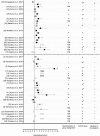Effects of Increased Loading on In Vivo Tendon Properties: A Systematic Review
- PMID: 25563908
- PMCID: PMC4535734
- DOI: 10.1249/MSS.0000000000000603
Effects of Increased Loading on In Vivo Tendon Properties: A Systematic Review
Abstract
Introduction: In vivo measurements have been used in the past two decades to investigate the effects of increased loading on tendon properties, yet the current understanding of tendon macroscopic changes to training is rather fragmented, limited to reports of tendon stiffening, supported by changes in material properties and/or tendon hypertrophy. The main aim of this review was to analyze the existing literature to gain further insights into tendon adaptations by extracting patterns of dose-response and time-course.
Methods: PubMed/Medline, SPORTDiscus, and Google Scholar databases were searched for studies examining the effect of training on material, mechanical, and morphological properties via longitudinal or cross-sectional designs.
Results: Thirty-five of 6440 peer-reviewed articles met the inclusion criteria. The key findings were i) the confirmation of a nearly systematic adaptation of tendon tissue to training, ii) the important variability in the observed changes in tendon properties between and within studies, and iii) the absence of a consistent incremental pattern regarding the dose-response or the time-course relation of tendon adaptation within the first months of training. However, long-term (years) training was associated with a larger tendon cross-sectional area, without any evidence of differences in material properties. Our analysis also highlighted several gaps in the existing literature, which may be addressed in future research.
Conclusions: In line with some cross-species observations about tendon design, tendon cross-sectional area allegedly constitutes the ultimate adjusting parameter to increased loading. We propose here a theoretical model placing tendon hypertrophy and adjustments in material properties as parts of the same adaptive continuum.
Figures






Similar articles
-
A rapid and systematic review of the clinical effectiveness and cost-effectiveness of paclitaxel, docetaxel, gemcitabine and vinorelbine in non-small-cell lung cancer.Health Technol Assess. 2001;5(32):1-195. doi: 10.3310/hta5320. Health Technol Assess. 2001. PMID: 12065068
-
Interventions for interpersonal communication about end of life care between health practitioners and affected people.Cochrane Database Syst Rev. 2022 Jul 8;7(7):CD013116. doi: 10.1002/14651858.CD013116.pub2. Cochrane Database Syst Rev. 2022. PMID: 35802350 Free PMC article.
-
The Lived Experience of Autistic Adults in Employment: A Systematic Search and Synthesis.Autism Adulthood. 2024 Dec 2;6(4):495-509. doi: 10.1089/aut.2022.0114. eCollection 2024 Dec. Autism Adulthood. 2024. PMID: 40018061 Review.
-
Conservative, physical and surgical interventions for managing faecal incontinence and constipation in adults with central neurological diseases.Cochrane Database Syst Rev. 2024 Oct 29;10(10):CD002115. doi: 10.1002/14651858.CD002115.pub6. Cochrane Database Syst Rev. 2024. PMID: 39470206
-
Tobacco packaging design for reducing tobacco use.Cochrane Database Syst Rev. 2017 Apr 27;4(4):CD011244. doi: 10.1002/14651858.CD011244.pub2. Cochrane Database Syst Rev. 2017. PMID: 28447363 Free PMC article.
Cited by
-
Quantification of cell density in rat Achilles tendon: development and application of a new method.Histochem Cell Biol. 2017 Jan;147(1):97-102. doi: 10.1007/s00418-016-1482-z. Epub 2016 Aug 26. Histochem Cell Biol. 2017. PMID: 27565969
-
Mohawk protects against tendon damage via suppressing Wnt/β-catenin pathway.Heliyon. 2024 Feb 6;10(4):e25658. doi: 10.1016/j.heliyon.2024.e25658. eCollection 2024 Feb 29. Heliyon. 2024. PMID: 38370202 Free PMC article.
-
Patellar tendon properties distinguish elite from non-elite soccer players and are related to peak horizontal but not vertical power.Eur J Appl Physiol. 2018 Aug;118(8):1737-1749. doi: 10.1007/s00421-018-3905-0. Epub 2018 Jun 2. Eur J Appl Physiol. 2018. PMID: 29860681 Free PMC article.
-
Rate of force development: physiological and methodological considerations.Eur J Appl Physiol. 2016 Jun;116(6):1091-116. doi: 10.1007/s00421-016-3346-6. Epub 2016 Mar 3. Eur J Appl Physiol. 2016. PMID: 26941023 Free PMC article. Review.
-
A comparison between the efficacy of eccentric exercise and extracorporeal shock wave therapy on tendon thickness, vascularity, and elasticity in Achilles tendinopathy: A randomized controlled trial.Turk J Phys Med Rehabil. 2022 Aug 25;68(3):372-380. doi: 10.5606/tftrd.2022.8113. eCollection 2022 Sep. Turk J Phys Med Rehabil. 2022. PMID: 36475111 Free PMC article.
References
-
- Arampatzis A, Karamanidis K, Albracht K. Adaptational responses of the human Achilles tendon by modulation of the applied cyclic strain magnitude. J Exp Biol. 2007; 210 (Pt 15): 2743– 53. - PubMed
-
- Arampatzis A, Karamanidis K, Mademli L, Albracht K. Plasticity of the human tendon to short- and long-term mechanical loading. Exerc Sport Sci Rev. 2009; 37 (2): 66– 72. - PubMed
-
- Arampatzis A, Karamanidis K, Morey-Klapsing G, De Monte G, Stafilidis S. Mechanical properties of the triceps surae tendon and aponeurosis in relation to intensity of sport activity. J Biomech. 2007; 40 (9): 1946– 52. - PubMed
-
- Arampatzis A, Peper A, Bierbaum S, Albracht K. Plasticity of human Achilles tendon mechanical and morphological properties in response to cyclic strain. J Biomech. 2010; 43 (16): 3073– 79. - PubMed
-
- Basso O, Johnson DP, Amis AA. The anatomy of the patellar tendon. Knee Surg Sports Traumatol Arthrosc. 2001; 9 (1): 2– 5. - PubMed
Publication types
MeSH terms
LinkOut - more resources
Full Text Sources
Miscellaneous

